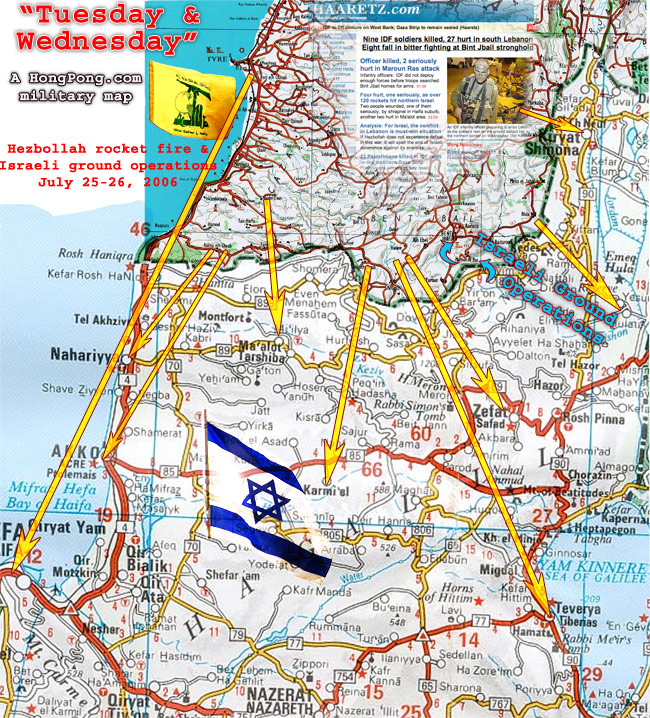
Dan Feidt's log on Minnesota, Information Operations, spinstorms and latent contradictions.
Haaretz: Four people hurt, one seriously, as over 120 rockets hit northern Israel
By Nir Hasson, Eli Ashkenazi, Jack Khoury, and Tomer Levi, Haaretz Correspondents
Four people were wounded Wednesday, one seriously and the rest lightly, as more than 100 rockets slammed into northern Israel. Another 14 people were treated for shock.
Two people were wounded by shrapnel while driving in a Haifa suburb, one of them seriously. Another two were hurt Wednesday afternoon in Ma'alot.
A barrage of rockets was fired at the Galilee and Kiryat Shmona. Dozens more struck the Haifa suburbs, Tiberias, Safed, Carmiel, the village of Jish and the Hula Valley during the day.
Based on this report I have prepped the following map:

The blue arrow farther north is the regional Lebanese capital of Bint Jbail. The site closer to the border is Maroun Ras. Note that the Israelis have not yet secured the Maroun Ras area from Hezbollah's anti-tank missile teams. Also note that despite Israel's heavy casualties, they haven't really gotten very far at all. Obviously I am guessing about the specific source locations of Hezbollah's rockets. The map was stitched together imperfectly from a couple different ones. And of course this doesn't feature the wide-ranging Israeli airstrikes on enemy chicken coops and kitchen sinks...
Five troops hurt in Hezbollah attack in Maroun Ras: Nine IDF soldiers killed in bitter south Lebanon fightingPosted by HongPong at July 26, 2006 07:16 PM
By Amos Harel and Eli Ashkenazi, Haaretz Correspondents
Nine Israel Defense Forces soldiers died Wednesday and 27 others were injured in the hardest day of fighting in southern Lebanon since the war began two weeks ago. Five of the injured soldiers are in serious condition. The IDF believes that Hezbollah lost 15 of its fighters in Wednesday's fighting.
Eight of the IDF dead - five soldiers and three officers - were from the Golani Brigade; they were killed in fighting in the town of Bint Jbail. The ninth soldier, a paratrooper, was killed last night in Maroun Ras. The IDF began its operation against Bint Jbail on Monday morning. By Tuesday evening, troops from the Golani and Paratroops Brigades had taken up positions on the outskirts of the town, and Golani soldiers had also entered some of the homes.
At approximately 5 A.M. Wednesday, Golani infantry entered Bint Jbail from the northeast and headed toward the center of town. The aim of the operation was to find and engage Hezbollah guerrillas and destroy their stores of arms.
According to initial reports, the guerrillas managed to ambush the IDF forces as they approached several homes on the outskirts of the town. Many of the Golani casualties occurred during this initial encounter, which took place at very close range. The initial battle raged for about an hour. During the next three hours, other platoons entered the area in an attempt to extricate the force that was pinned down. Hezbollah forces fired antitank missiles and threw grenades at the force it had caught in its ambush, and it also used mortars to attack the supporting IDF units. A total of 22 soldiers suffered injuries, including two platoon commanders. Three of the casualties were seriously wounded, four were moderately hurt and 15 had light wounds. The evacuation of the injured was particularly difficult because of the heavy fire in the area.
The IDF's Northern Command was initially reluctant to deploy attack helicopters in the battle, due to concerns that Hezbollah might succeed in shooting down one of them. However, the delay in the evacuation of the wounded led to a decision to deploy the helicopters. The evacuation, which was finally accomplished only six hours after the start of the battle, utilized four Blackhawk helicopters that landed two kilometers from the scene of the fighting. The soldiers carried their injured comrades on foot to the improvised landing strip.
While the operation was being carried out, Bint Jbail was subjected to heavy and sustained fire, and the helicopter landing area was covered in smoke in order to conceal the choppers' presence from Hezbollah snipers and missiles. The helicopters stayed on the ground no more than a minute each before evacuating the wounded to Rambam Medical Center in Haifa. The fighting in the town continued into the evening, and included aerial attacks on the center of the town by the Israel Air Force.
Later in the evening, in the nearby town of Maroun Ras, Hezbollah guerrillas fired an antitank missile at a force of paratroopers, killing one and seriously wounding two others. Another paratrooper suffered moderate injuries and two others were lightly hurt. All were evacuated to Rambam Medical Center in Haifa. Major General Udi Adam, the GOC Northern Command, said Wednesday that "the soldiers displayed sangfroid, bravery and professionalism after they came under fire, and they succeeded in killing many terrorists. In the IDF, we estimate that at least 15 Hezbollah guerrillas were killed in the village. There are also assessments that put the number of casualties on the Lebanese side at 40 to 50 dead fighters."
Senior officers in the Northern Command said Wednesday night that at this stage, they have a very limited picture of what transpired. However, officers in the Golani and Paratroops Brigades charged that the IDF employed insufficient force before the soldiers were deployed to search the homes. They said that once the civilians had been told to leave the town, the army should have regarded Bint Jbail as a battlefield and destroyed any home where Hezbollah guerrillas were suspected of hiding.
They also charged that not enough aircraft were used to attack targets. The IDF's modus operandi in southern Lebanon in recent days has sparked great debate among all ranks of the army. Many field officers argue that insufficient forces are being deployed in the fighting and that the army is being ineffective against Katyusha rocket launchers.